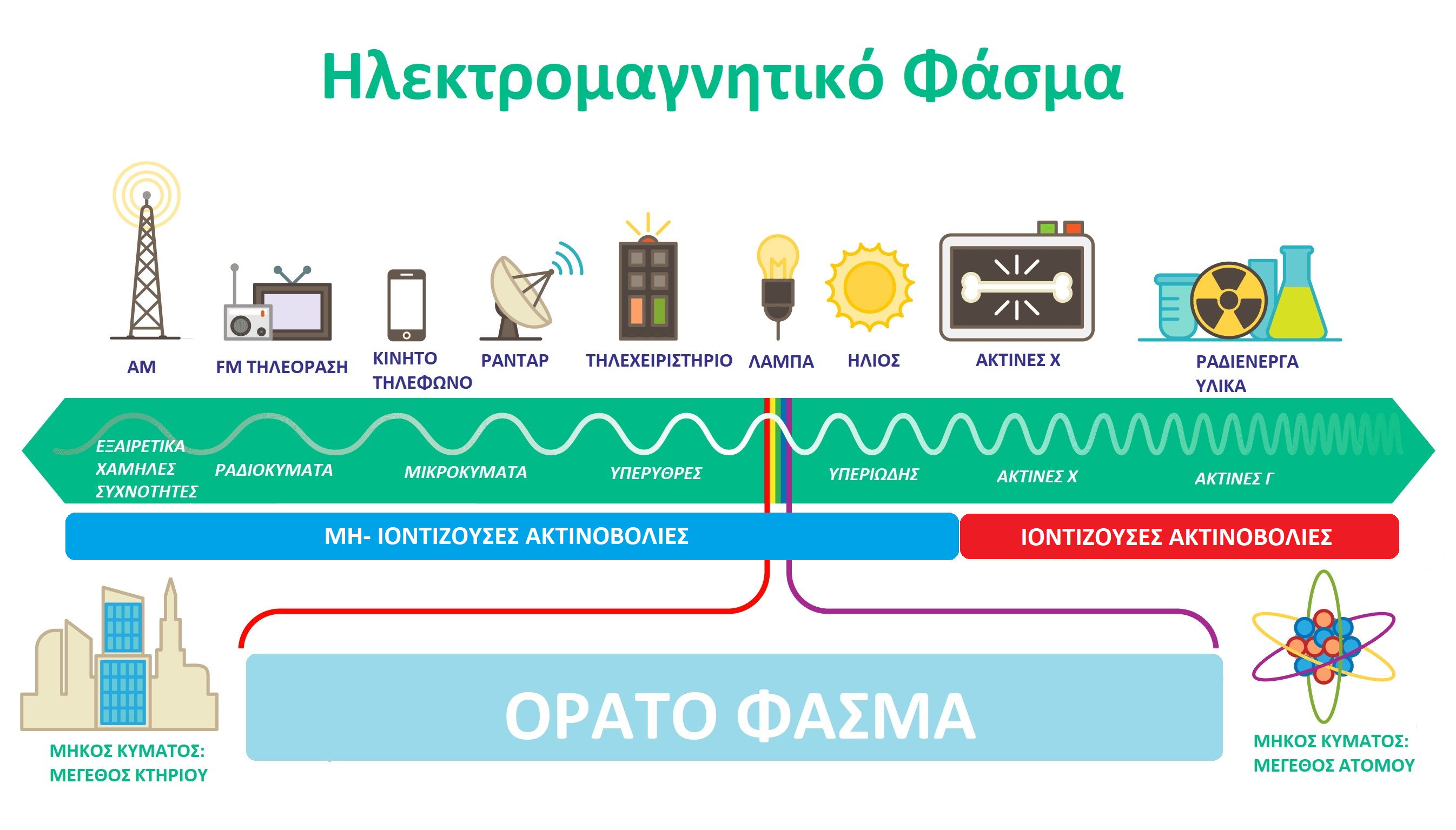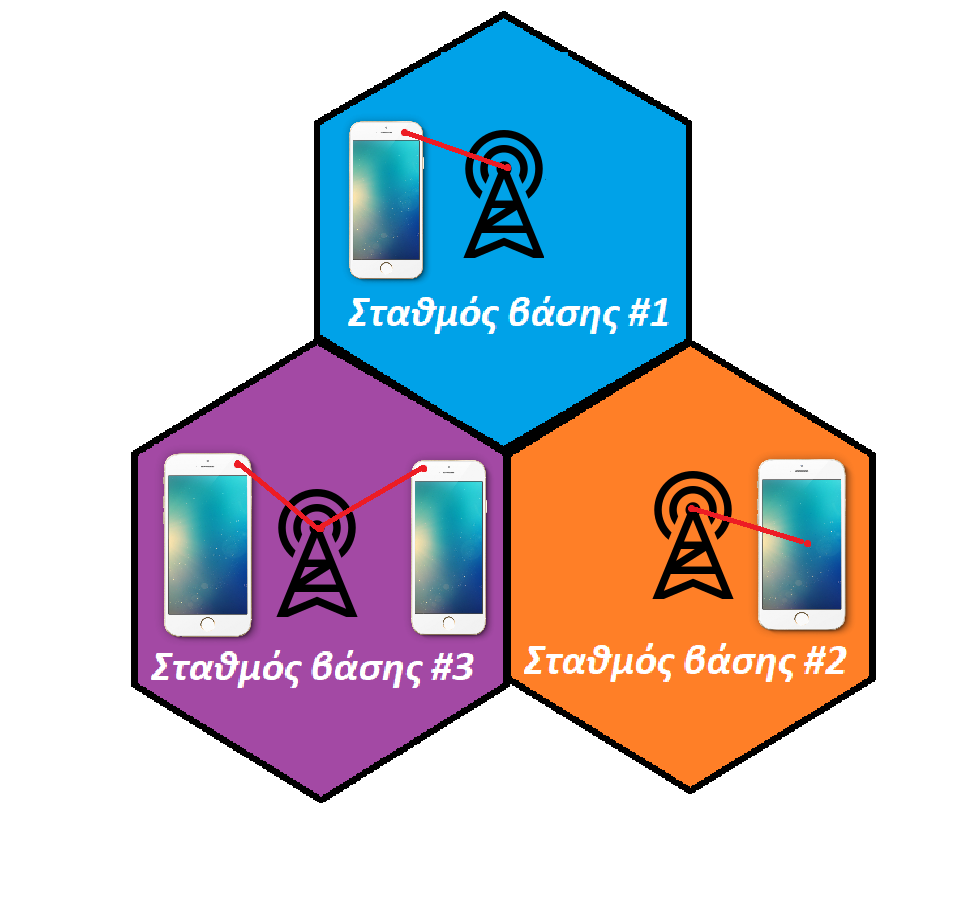The program PEDION 24 aims to continuously record (on a 24-hour basis) the levels of electromagnetic radiation in various parts of Greece and posting the results online. The system PEDION 24 consists of stations for measuring the levels of electromagnetic radiation, installed in various areas. The measuring stations are equipped with special, certified electric field measuring instruments which every 6 minutes record and store in their memory an electric field intensity value. Every 24 hours the measuring stations communicate through the GSM network with the management center and send the data to the central server where they are processed and published on the internet.
The measuring stations of the PEDION 24 program record on a 24-hour basis the intensity values of the electromagnetic field in the frequency range from 100kHz to 7GHz. Most of the wireless telecommunication services in our country operate in this area of the electromagnetic spectrum. Specifically, radio, television, mobile telephony (2G, 3G, 4G), wireless networks (Wi-Fi) and other services broadcast in this frequency band. Thus the FIELD 24 program provides a comprehensive information on the levels of electromagnetic radiation resulting from the aforementioned sources.
The program PEDION 24 was implemented by the Mobile Radiocommunication Laboratory of the National Technical University of Athens, the Radiocommunications Laboratory of the Aristotle University of Thessaloniki, the Computer & Communications Laboratory of the University of the Aegean, the Laboratory of Internet and Telecommunications, Internet and Telecommunications Services. The 4 Greek Universities manage the Pedion 24 program daily and are responsible for the valid and timely information of the public.
These are oscillations of electric and magnetic fields that propagate as waves at the speed of light. Our electromagnetic radiation is known in the natural and artificial environment in various forms. Infrared radiation, visible light, ultraviolet radiation, X-rays are part of the electromagnetic spectrum as well as radio and television frequencies, microwaves and the electric and magnetic fields of the electric railway and power lines. As for the radiation of mobile telephony, it is the electromagnetic radiation in the frequency range 900 MHz and 1800 MHz. From a physical point of view, these different radiations are different in their frequency and their energy .
Based on in their frequency The emitted radiation is divided into "non-ionizing" and "ionizing".
The ionizing radiation is characterized by very high emission frequencies and has the property of causing ionization of atoms (i.e. to expel an electron from an atom). For this reason ionizing radiation can cause damage to cells, tissues and more generally to biological organisms. Examples of ionizing radiation are X-rays and C-rays emitted by radioactive materials. Non ionizing radiation does not cause ionization of atoms. Examples of non-ionizing radiation are visible light, ultraviolet radiation, infrared light, radio waves and microwaves. Emissions from radio, television, mobile telephony, satellite systems and radar antennas, ie the total electromagnetic radiation of radio frequencies is Non ionizing radiation. The following figure shows the electromagnetic spectrum:

In relation to the energy they carry, electromagnetic waves can be described by the following quantities:
- Electric field strength E (unit of measurement: Volts per meter - V/m)
- Magnetic field strength H (unit of measurement: Ampere per meter - A/m)
- Power Flow Density S (unit of measurement: Watt per square meter - W/m2)
In the radio frequency range the basic quantity that characterizes electromagnetic fields is Electric Field Intensity which is recorded under the program PEDION 24 .
There are three physical quantities that describe the intensity of electromagnetic radiation:
- the electric field strength, measured in V / m
- the intensity of the magnetic field, measured in A / m
- the power density measured in W / m².
Mobile phones and base stations emit electromagnetic radiation, ie oscillations of electric and magnetic fields that propagate in space in the form of a wave carrying energy. The different types of electromagnetic radiation are distinguished from each other depending on the frequency or wavelength of the propagating wave. Frequency and wavelength are two inversely proportional quantities, that is, the lower the frequency, the greater the wavelength.
For electromagnetic radiation emissions in accordance with the Recommendation of the Council of the European Union "On limiting public exposure to electromagnetic fields 0 Hz - 300 GHz" (L 199, 1999/519 / EC) laying down basic restrictions and reference levels for the levels of electromagnetic radiation induced by these antennas. The Greek state has set stricter safe exposure limits compared to the limits set by the European Union. According to the Greek Legislation, the way of the measurements is ensured, control mechanisms are defined for the H / M radiation levels as well as the installation of antennas which has not been approved by authorized bodies is prohibited.
The radiated power from an antenna in one direction is not constant, but it decreases very fast compared to the distance. The reduction in the radiated power is inverse of the square of the distance, ie at a distance of twice it falls on a quarter of the radiation and at a distance of ten times a centimeter.
The main feature of Mobile Communication Systems is their cellular structure. The design of radio networks is based on this structure. Each cell serves through a base station (NW) a geographical area with a radius of a few meters to a few tens of kilometers. The S.B. are connected to the switching centers, which connect the radio network to the external voice and data networks. In the S.B. we assign a set of frequencies (channels) to each cell and seek to reuse the same channels in space. Dense reuse implies high spectral efficiency but also an increase in unwanted co-channel interference.

It is a common misconception that to achieve twice the distance in a radio coverage connection, we can simply double the power. The reality is that to double the distance, 4 times the transmission power is required. This rule comes from a simple geometric formula that states that the propagation of radio waves extends in the shape of a sphere and the surface area of a sphere (and therefore power density) changes in proportion to the square of the radius (in this case the radius is the distance).
In other words, if we use a 1 Watt transmitter we can cover a distance of 1 km, to reach 2 km we will need a 4 Watt transmitter. Of course the radio coverage distance depends not only on the power of a transmitter, but also on the gain and height of the antenna, the quality of the receiver and the obstacles on the ground.
The established levels have been established taking into account the uncertainties of factors such as environmental conditions and the different states of physical well-being of the public. According to Greek standards, the limits constitute 70% of the EU prices. and especially for vulnerable groups, the resulting prices amount to 60% of the initial prices, ensuring full security and compliance with current legislation throughout Greece.
5G technology is the only technology available with which a doctor in an urban environment can reliably examine, with high definition and using devices and robotic mechanisms to operate as well as palpate the tissues of a patient located on a remote island. Also 5G technology is the only one that can support remote diagnostics using experienced artificial intelligence systems.
The Digitization of the Economy is evolving rapidly offering recognized benefits. The development of 5G networks is the catalyst for the deepening of the Digital Economy. The possibility of access to new markets and the increase of the part of the population to which they are addressed, the reduction of production costs and the increase of productivity as well as the creation of conditions for the rapid adoption of innovation at all stages of their production processes are some of the benefits.
Due to the globalization of the economy, industries and countries that are moving faster towards the Digital Economy have a decisive advantage over the backward ones for the future and sustainable development. The development of 5G technology can be a unique factor and pole for the development and production of innovation and Greece can only benefit from its timely adoption. A slow and passive adoption of 5G can only have negative effects for the country, as others (countries and industries) will have gained valuable experience in their rapid and efficient transition to the Digital Economy, both through the timely development of new services and cases. as well as through the production and export of innovation.
Radiation from mobile phones and base stations is not radioactive. We refer to non-ionizing E / M radiation which does not cause ionization of the molecules. The electromagnetic spectrum includes the following non-ionizing E / M radiation:
- Static electric and Magnetic Fields that are unchanged (eg the Earth's natural magnetic field)
- Electric and Magnetic fields of the order of 50Hz (eg electrical appliances, substations, power distribution lines)
- Radio waves (eg radio and television broadcasting, radar)
- Light
- Infrared (eg bodies with high temperature)
- Ultraviolet (eg sun)
